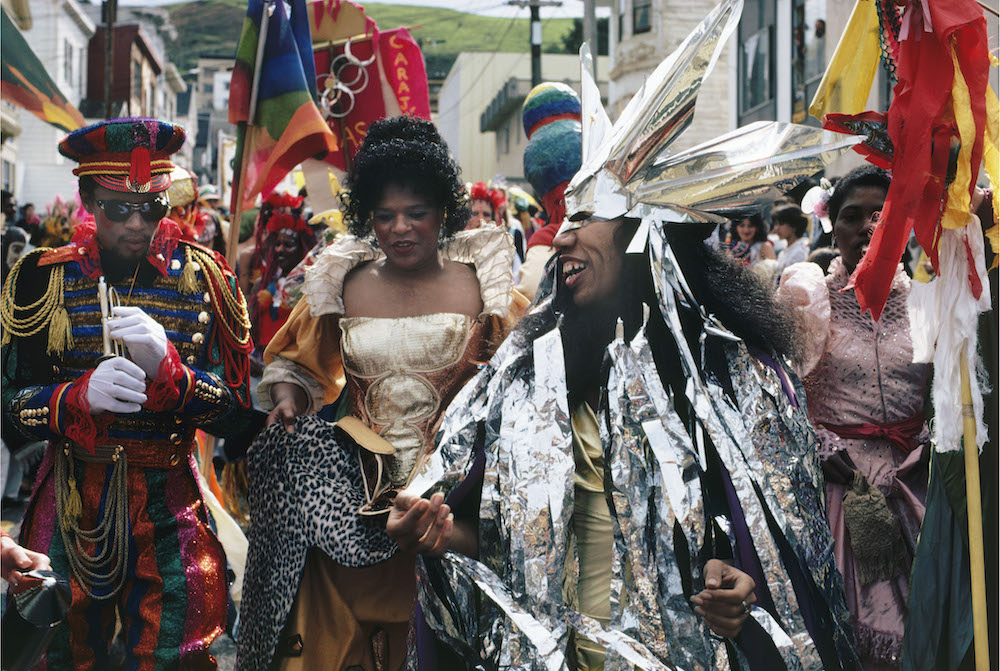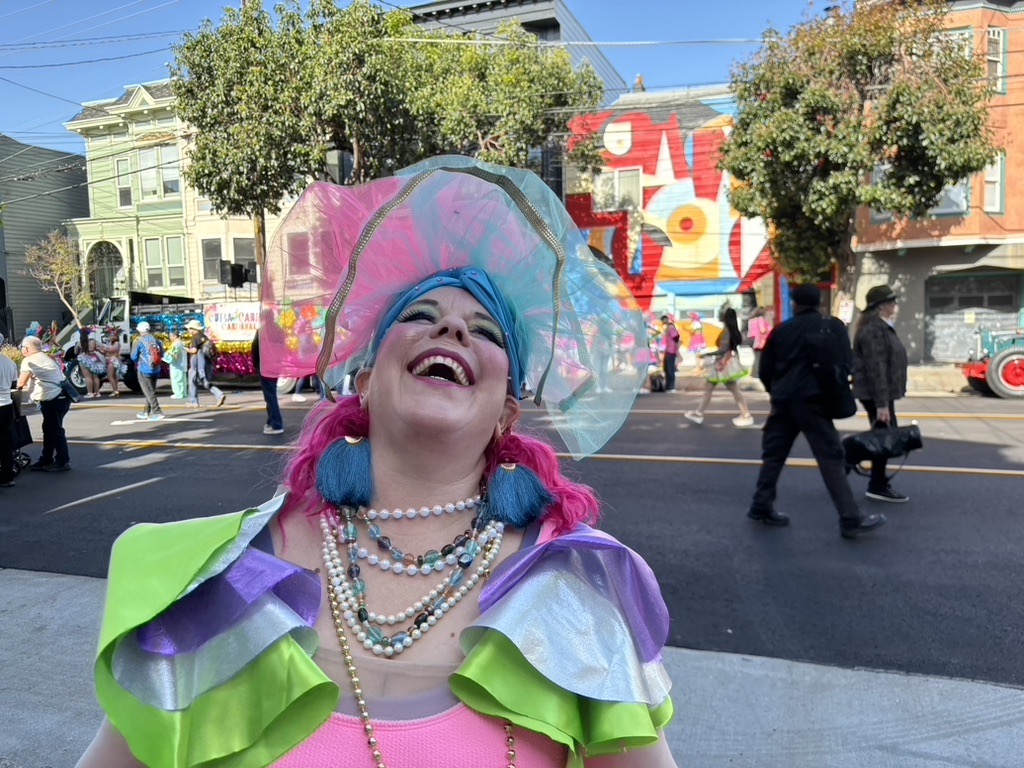Like a lot of people who have lived in San Francisco for decades, I often bemoan the changes in the city that have driven out artists and musicians and sanitized and gentrified neighborhoods that were once filled with a lot of character and creativity. I live in the Haight, where, in my 20s and 30s, I used to be able to dance every night of the week to live bands at several venues; recently, the last of these, the Club Deluxe, shuttered for good, unable to meet the high rents of its corporate owner.
That’s why, more and more, I find myself drifting down to the Mission. Yes, Valencia St. is nearly unrecognizable since the gritty days when it was inhabited mainly by lesbians and Latinos. Yes, the tech booms have made rents there inaccessible for most people. But still, there’s a life force that courses through the Mission, pumping blood into the heart of the city to the drumbeats of a wide variety of cultures from Latin America, the Caribbean, Africa, indigenous Americans and beyond. There’s still a vibrant dance and music scene in the Mission, and you can still buy a burrito big enough to last you for two days.
Nowhere can you feel those heartbeats and the spirit behind them than at Carnaval, the free two-day parade and festival, which celebrated its 46th year last weekend, that draws thousands of joyful participants and spectators to the neighborhood. The parade this year, with the theme “Honoring Our Roots,” featured 69 contingents with low-riders, floats, dancers, musicians, and kids, all in colorful costumes.
Carnaval has become so important as the premiere cultural celebration on the West coast that Nobel Peace Prize laureate Rigoberta Menchú Tum, the Guatemalan activist, acted as parade marshal, seated on the float alongside the King and Queen. People not only dance in the streets, but on the sidewalks, and for a day, the Mission turns into a barrio full of feathers, beads, headdresses, salsa music, pupusa vendors and takeaway margaritas. People come from all over the Bay Area to experience this community of celebration and delight.

SF Carnaval’s deep roots in community
I danced this year with Cuba Caribe, whose live Cuban musicians drummed for our contingent of kids and dancers, all festooned in hot pink and turquoise. Along 24th Street, while doing some salsa moves with our comparsa, I noticed Lou Dematteis taking photos (along with thousands of spectators shooting from their phones). Lou, a professional photographer who is a Mission activist and spent years in Nicaragua and Central America shooting the conflicts there, was one of the founding members of Carnaval. The day after the parade, I called him to chat about those early days.
San Francisco Carnaval, he said, was the brainchild of a samba dance teacher named Adela Chu, originally from Panama. She staged a Carnaval-themed dance at San Francisco’s Masonic Temple in 1976, and organized a Carnaval performance with Ana Halprin’s Dance Company at the 24th St. BART Station. The next year, she created a Carnaval at Ocean Beach—a kind of precursor to BurningMan. In an article for Shaping San Francisco’s FoundSF, Peruvian-born writer/photographer Willy Lizárraga wrote, “She wasn’t creating or importing an event so much as simply giving San Francisco’s drummers and dancers a chance to come together in a slightly more focused and organized fashion.”
Chu visited Brazil, and came back the next year determined to have a parade. She and a group of dancers, artists, and musicians—including, among others, Cuban drumming master Marcus Gordan, costume designer Pam Minor, Sir Lawrence Washington, Lou Dematteis, and acclaimed local percussionist John Santos, who was teaching drumming at the time at the Precita Cultural Center—planned for a parade at Carnaval time, in February of 1979.
Help us save local journalism!
Every tax-deductible donation helps us grow to cover the issues that mean the most to our community. Become a 48 Hills Hero and support the only daily progressive news source in the Bay Area.
Just three months before the event, San Francisco suffered the tragic blows of the assassinations of Mayor George Moscone and Supervisor Harvey Milk. That very same week, in Guyana, hundreds of Bay Area residents died at the Jonestown massacre. But the organizers decided the show must go on.
That first year, Carnaval, with perhaps 300 participants, paraded around Precita Park a few times in the rain, Lou recalls. In 1980, the parade moved to Dolores Park. After a couple of years, San Francisco officials wanted the parade moved to the Civic Center, which caused the organizers to split, with some, like Chu, bowing out, because they felt it should be in the Mission to retain its cultural flavor. Eventually, Carnaval moved back to the Mission, and the festival portion of events opened on Harrison Street.
Lou says that when some condos were built on Harrison Street, some neighbors complained about the Carnaval bands and noise, but housing activists in the neighborhood had foreseen that trouble. “There was a clause in their leases that said that Carnaval happens nearby and they weren’t going to shut it down because it made too much noise.”
Activists in the Mission were also responsible for stepping up to save Carnaval about ten years ago, Lou says, when the non-profit that had been managing it was going under. “The Mission community stepped in to save it.”
It’s that community, he says, that is also responsible for getting 3,600 units of affordable housing built in the neighborhood, and helping to protect small businesses. “Over the years there’s been a movement within the Mission community to maintain what a wonderful neighborhood the Mission is, and Carnaval is one of the things that gives the Mission life,” says Lou. “I don’t buy the idea that the Mission is dying. The Mission is a living organism and Carnaval helps keep it alive.

Creating community with Carnaval
I’ve only participated in Carnaval three times, twice with former Carnaval Queen Elizabeth Soberanes’ large Latin Dance Grooves contingent, and this year with Cuba Caribe. Many people in Carnaval participate year after year, planning their entire spring around an event that lasts only a few hours.
It’s a big commitment: This year, we had 10 weeks of rehearsals, some outside in the cold. We paid for costumes we’ll likely never wear again. We had to wake up very early in the morning to apply makeup, glue on false eyelashes, make last-minute costume adjustments, and figure out how to get to the Mission without being able to park anywhere nearby. (One year, when I foolishly tried to drive, I called a friend who lived not far from the staging area who heroically showed up when asked him to rescue my car and go park it somewhere.)
Then we wait in the staging area, taking photos and queuing in long lines to use the porta-potties, unless some neighbor on Bryant is kind enough to let strangers in to use their bathroom. If it’s cold out, you shiver in your skimpy costume. Then you have to dance 20 blocks on concrete, which is difficult even if you’re not wearing 6-inch heels, like the samba dancers.
But as with most artistic pursuits, the process is as important as the final presentation. During the ten weeks of classes I got to know and appreciate a diverse group of dancers, many of whom would linger after class, sitting in the sun at a nearby bakery. I took classes with the best Cuban dance teachers and musicians in the Bay Area, Susana Arenas, Ramon Ramos Alayo, and Miguel Suarez. I appreciated that while they were serious about the choreography, and wanted us to do it right, they emphasized that Carnaval is about having fun, the dances playful and sexy.
“In Cuba, people hear the music and they come running out to come dance in the parade,” Ramon said. “It doesn’t have to be perfect. Don’t worry about being perfect.”
I’ve enjoyed taking classes with Ramon (who founded Cuba Caribe) and Susana over the years because they are both so generous about sharing their dance and their culture with whoever shows up in the studio. They both have their own professional dance companies, but they encourage amateurs like me because they are motivated by sharing and preserving their cultural traditions.
As a white woman who loves to dance but grew up in a household with very little music, who even has relatives who don’t dance because it goes against their religion, it’s been a joy to be able to learn Cuban dances, as it has been a joy to be able to participate in Carnaval. And as a long-time San Franciscan, it does my heart good to know that no matter how else the city is hollowed out of its creativity, there are always great dance classes in the Mission, and once a year, there’s always Carnaval.




